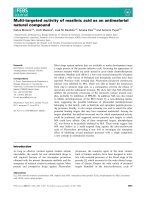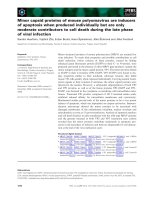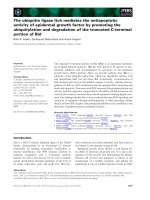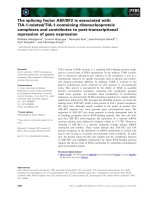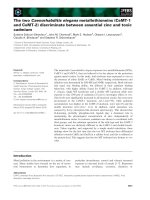Tài liệu Báo cáo khoa học: "The grapho-phonological system of written French: Statistical analysis and empirical validation" pdf
Bạn đang xem bản rút gọn của tài liệu. Xem và tải ngay bản đầy đủ của tài liệu tại đây (632.07 KB, 7 trang )
The grapho-phonological system of written French: Statistical
analysis and empirical validation
Marielle Lange
Laboratory of Experimental Psychology,
Universit6 Libre de BruxeUes
Av. F.D. Roosevelt, 50
Bruxelles, Belgium, B 1050 Bruxelles
Alain Content
Laboratory of Experimental Psychology,
Universit6 Libre de Bruxelles
Av. F.D. Roosevelt, 50
Bruxelles, Belgium, B 1050 Bruxelles
Abstract
The processes through which readers evoke
mental representations of phonological forms
from print constitute a hotly debated and
controversial issue in current psycholinguistics. In
this paper we present a computational analysis of
the grapho-phonological system of written
French, and an empirical validation of some of the
obtained descriptive statistics. The results provide
direct evidence demonstrating that both grapheme
frequency and grapheme entropy influence
performance on pseudoword naming. We discuss
the implications of those findings for current
models of phonological coding in visual word
recognition.
Introduction
One central characteristic of alphabetic writing
systems is the existence of a direct mapping
between letters or letter groups and phonemes. In
most languages, although to a varying extent, the
mapping from print to sound can be characterized
as quasi-systematic (Plaut, McClelland,
Seidenberg, & Patterson, 1996; Chater &
Christiansen, 1998). Thus, descriptively, in
addition to a large body of regularities (e.g. the
grapheme CH in French regularly maps onto/~/),
one generally observes isolated deviations (e.g.
CH in CHAOS maps onto /k/)as well as
ambiguities. In some cases but not always, these
difficulties can be alleviated by considering higher
order regularities such as local orthographic
environment (e.g., C maps onto /k/ or/s/ as a
function of the following letter), phonotactic and
phonological constraints as well as morphological
properties (Cf. PH in PHASE vs. SHEPHERD).
One additional difficulty stems from the fact that
the
graphemes,
the orthographic counterparts of
phonemes, can consist either of single letters or of
letter groups, as the previous examples illustrate.
Psycholinguistic theories of visual word
recognition have taken the quasi-systematicity of
writing into account in two opposite ways. In one
framework, generally known as dual-route
theories (e.g. Coltheart, 1978; Coltheart, Curtis,
Atkins, &Haller, 1993), it is assumed that
dominant mapping regularities are abstracted to
derive a tabulation of grapheme-phoneme
correspondence rules, which may then be looked
up to derive a pronunciation for any letter string.
Because the rule table only captures the dominant
regularities, it needs to be complemented by
lexical knowledge to handle deviations and
ambiguities (i.e., CHAOS, SHEPHERD). The
opposite view, based on the parallel distributed
processing framework, assumes that the whole set
of grapho-phonological regularities is captured
through differentially weighted associations
between letter coding and phoneme coding units
of varying sizes (Seidenberg & McClelland, 1989;
Plaut, Seidenberg, McClelland & Patterson,
1996).
These opposing theories have nourished an
ongoing complex empirical debate for a number
of years. This controversy constitutes one instance
of a more general issue in cognitive science,
which bears upon the proper explanation of rule-
like behavior. Is the language user's capacity to
exploit print-sound regularities, for instance to
generate a plausible pronunciation for a new,
unfamiliar string of letters, best explained by
knowledge of abstract all-or-none rules, or of the
436
statistical structure of the language? We believe
that, in the field of visual word processing, the
lack of precise quantitative descriptions of the
mapping system is one factor that has impeded
resolution of these issues.
In this paper, we present a descriptive analysis of
the grapheme-phoneme mapping system of the
French orthography, and we further explore the
sensitivity of adult human readers to some
characteristics of this mapping. The results
indicate that human naming performance is
influenced by the frequency of graphemic units in
the language and by the predictability of their
mapping to phonemes. We argue that these results
implicate the availability of graded knowledge of
grapheme-phoneme mappings and hence, that
they are more consistent with a parallel distributed
approach than with the abstract rules hypothesis.
.
Statistical analysis of grapho-
phonological correspondences of
French
1.1. Method
Tables of grapheme-phoneme associations
(henceforth, GPA) were derived from a corpus of
18.510 French one-to-three-syllable words from
the BRULEX Database (Content, Mousty, &
Radeau, 1990), which contains orthographic and
phonological forms as well as word frequency
statistics. As noted above, given that graphemes
may consist of several letters, the segmentation of
letter strings into graphemic units is a non-trivial
operation. A semi-automatic procedure similar to
the rule-learning algorithm developed by
Coltheart
et al.
(1993) was used to parse words
into graphemes.
First, grapheme-phoneme associations are
tabulated for all trivial cases, that is, words which
have exactly the same number of graphemes and
phonemes (i.e. PAR,/paR/). Then a segmentation
algorithm is applied to the remaining unparsed
words in successive passes. The aim is to select
words for which the addition of a single new GPA
would resolve the parsing. After each pass, the
new hypothesized associations are manually
checked before inclusion in the GPA table.
The segmentation algorithm proceeds as follows.
Each unparsed word in the corpus is scanned from
left to right, starting with larger letter groups, in
order to find a parsing based on tabulated GPAs
which satisfies the phonology. If this fails, a new
GPA will be hypothesized if there is only one
unassigned letter group and one unassigned
phoneme and their positions match. For instance,
the single-letter grapheme-phoneme associations
tabulated at the initial stage would be used to
mark the P-/p/and R-/R/correspondences in the
word POUR (/puRl) and isolate OU-/u/as a new
plausible association.
When all words were parsed into graphemes, a
80
70
60
50
40
30
20
10
0
Grapheme-Phoneme
Association Probability
Figure 1. Distribution of Grapheme-Phoneme Association
probablity, based on type measures.
70
Grapheme Entropy (H)
60 !
Most unpredictable graphemes
50 ! (H • .90)
Vowels:
e, oe, u, ay, eu, 'i
40 Consonants: x, s, t, g, II, c
3o
20
10
o
o ~ d o d o d o o d
Figure2. Dis~ibutionof~aphemeEn~y(H) values,
b~on~eme~rcs.
437
Predictibility of Grapheme-Phoneme Associations in French
GPA probability GPA probability H (type) H (token)
(type) (token)
Numberof
pmnunci=ions
M SD M SD M SD M SD M SD
All 1.70 (1.26) .60 (.42) .60 (.43) .27 (.45) .23 (.42)
Vowels 1.66 (1.12) .60 (.41) .60 (.44) .29 (.48) .21 (.41)
Consonants 1.76 (1.23) .60 (.42) .60 (.42) .25 (.42) .26 (.44)
Table I. Number of different pronunciations of a grapheme, grapheme-phoneme association (GPA) probability, and
entropy (H) values, by type and by token, for French polysyllabic words.
final pass through the whole corpus computed
grapheme-phoneme association frequencies, based
both on a type count (the number of words
containing a given GPA) and a token count (the
number of words weighted by word frequency).
Several statistics were then extracted to provide a
quantitative description of the grapheme-phoneme
system of French. (1)
Grapheme frequency,
the
number of occurrences of the grapheme in the
corpus, independently of its phonological value.
(2)
Number of alternative pronunciations
for each
grapheme. (3)
Grapheme entropy
as measured by
H, the information statistic proposed by Shannon
(1948) and previously used by Treiman,
Mullennix, Bijeljac-Babic, & Richmond-Welty
(1995). This measure is based on the probability
distribution of the phoneme set for a given
grapheme and reflects the degree of predictability
of its pronunciation. H is minimal and equals 0
when a grapheme is invariably associated to one
phoneme (as for J and/3/)- H is maximal and
equals
logs n
when there is total uncertainty. In
this particular case, n would correspond to the
total number of phonemes in the language (thus,
since there are 46 phonemes, max H = 5.52). (4)
Grapheme-phoneme association probability,
which is the GPA frequency divided by the total
grapheme frequency. (5)
Association dominance
rank,
which is the rank of a given grapheme-
phoneme association among the phonemic
alternatives for a grapheme, ordered by decreasing
probability.
1.2. Results
Despite its well-known complexity and ambiguity
in the transcoding from sound to spelling, the
French orthography is generally claimed to be
very systematic in the reverse conversion of
spelling to sound. The latter claim is confirmed by
the present analysis. The grapheme-phoneme
associations system of French is globally quite
predictable. The GPA table includes 103
graphemes and 172 associations, and the mean
association probability is relatively high (i.e.,
0.60). Furthermore, a look at the distribution of
grapheme-phoneme association probabilities
(Figure 1) reveals that more than 40% of the
associations are completely regular and
unambiguous. When multiple pronunciations exist
(on average, 1.70 pronunciations for a grapheme),
the alternative pronunciations are generally
characterized by low GPA probability values (i.e.,
below 0.15).
The predictability of GPAs is confirmed by a very
low mean entropy value. The mean entropy value
for all graphemes is 0.27. As a comparison point,
if each grapheme in the set was associated with
two phonemes with probabilities of 0.95 and 0.05,
the mean H value would be 0.29. There is no
notable difference between vowel and consonant
predictability. Finally, it is worth noting that in
general, the descriptive statistics are similar for
type and token counts.
2. Empirical study: Grapheme frequency
and grapheme entropy
To assess readers' sensitivity to grapheme
frequency and grapheme entropy we collected
naming latencies for pseudowords contrasted on
those two dimensions.
438
I I • II I •
Grapheme Frequency Grapheme Entropy
Low High Low High
Latencies
Immediate Naming 609 (75) 585 (66) 596 (72) 644 (93)
Delayed Naming 335 (42) 342 (53) 333 (51) 360 (54)
Delta Scores 274 (94) 243 (84) 263 (94) 284 (105)
Errors
Immediate Naming 8.1 (7.0) 8.9 (5.8) 9.2 (4.7) 14.2 (7.3)
Dela~ced Namin~ 2.7 ~3.41 3.9 ~5.7) 2.5 ~2.4 / 8.0 ~6.3 /
Table 2. Average reaction times and errors for the grapheme frequency and grapheme entropy (uncertainty)
manipulations (standard deviations are indicated into parentheses) in the immediate and delayed naming tasks.
2.1. Method
Participants. Twenty French-speaking students
from the Free University of Brussels took part in
the experiment for course credits. All had normal
or corrected to normal vision.
Materials. Two lists of 64 pseudowords were
constructed. The first list contrasted grapheme
frequency and the second manipulated grapheme
entropy. The grapheme frequency and grapheme
entropy estimates for pseudowords were
computed by averaging respectively grapheme
frequency or grapheme entropy across all
graphemes in the letter string. Low and high
values items were selected among the lowest 30%
and highest 30% values in a database of about
15.000 pseudowords constructed by combining
phonotactically legal consonant and vocalic
clusters.
The frequency list comprised 32 pairs of items. In
each pair, one pseudoword had a high averaged
grapheme frequency, and the other had a low
averaged grapheme frequency, with entropy kept
constant. Similarly, the entropy list included 32
pairs of pseudowords with contrasting average
values of entropy and close values of average
grapheme frequency.
In addition, stimuli in a matched pair were
controlled for a number of orthographic properties
known to influence naming latency (number of
letters and phonemes; lexical neighborhood size;
number of body friends; positional and non
positional bigram frequency; grapheme
segmentation probability; grapheme complexity).
Procedure. Participants were tested individually
in a computerized situation (PC and MEL
experimentation software). They were
successively tested in a immediate naming and a
delayed naming task with the same stimuli. In the
immediate naming condition, participants were
instructed to read aloud pseudowords as quickly
and as accurately as possible, and we recorded
response times and errors. In the delayed naming
task, the same stimuli were presented in a
different random order, but participants were
required to delay their overt response until a
response signal appeared on screen. The delay
varied randomly from trial to trial between 1200
and 1500 msec. Since participants are instructed
to fully prepare their response for overt
pronunciation during the delay period, the delayed
naming procedure is meant to provide an estimate
of potential artefactual differences between
stimulus sets due to articulatory factors and to
differential sensitivity of the microphone to
various onset phonemes.
Pseudowords were presented in a random order,
different for each participant, with a pause after
blocks of 32 stimuli. They were displayed in
lower case, in white on a black background. In the
immediate naming task, each trial began with a
fixation sign (*) presented at the center of the
screen for 300 msec. It was followed by a black
screen for 200 msee and then a pseudoword which
stayed on the screen until the vocal response
triggered the microphone or for a maximum delay
of 2000 msec. An interstimulus screen was finally
presented for 1000 msee. In the delayed naming
task, the fixation point and the black screen were
439
followed by a pseudoword presented for 1500
msec, followed by a random delay between 1300
and 1500 msec. After this variable delay, a go
signal (####) was displayed in the center of the
screen till a vocal response triggered the
microphone or for a maximum duration of 2000
msec. Pronunciation errors, hesitations and
triggering of the microphone by extraneous noises
were noted by hand by the experimenter during
the experiment.
2.2. Results
Data associated with inappropriate triggering of
the microphone were discarded from the error
analyses. In addition, for the response time
analyses, pronunciation errors, hesitations, and
anticipations in the delayed naming task were
eliminated. Latencies outside an interval of two
standard deviations above and below the mean by
subject and condition were replaced by the
corresponding mean. Average reaction times and
error rates were then computed by subjects and by
items in both the immediate naming and the
delayed naming task. By-subjects and by-items
(Ft and F2, respectively) analyses of variance
were performed with grapheme frequency and
grapheme entropy as within-subject factors.
Grapheme frequency.
For naming latencies,
pseudowords of low grapheme frequency were
read 24 msec more slowly than pseudowords of
high grapheme frequency. This difference was
highly significant both by subjects and by items;
Fj(1, 19) = 24.4, p < .001, Fe(1, 31) = 7.5, p <
.001. On delayed naming times, the same
comparison gave a nonsignificant difference of-7
msec. For pronunciation errors, there was no
significant difference in the immediate naming
task. In the delayed naming task, pseudowords of
low mean grapheme frequency caused 1.2% more
errors than high ones. This difference was
marginally significant by items, but not significant
by subjects; F2(1, 31) = 3.1,p < .1.
Grapheme entropy.
In the immediate naming
task, high-entropy pseudowords were read 48
msec slower than low-entropy pseudowords; FI(1,
19) = 45.4,p < .001, Fe(1, 31) = 16.2,p < .001. In
the delayed naming task, the same comparison
showed a significant difference of 27 msec; FI(1,
19) = 22.9 p < .001, F2(1, 31) = 12.5, p < .005.
Because of this articulatory effect, delta scores
were computed by subtracting delayed naming
times from immediate naming times. A significant
difference of 21 msec was found on delta scores;
FI(1, 19) = 5.7,p < .05, F2(1, 31) = 4.7,p < .05.
The pattern of results was similar for errors. In the
immediate naming task, high-entropy
pseudowords caused 5% more errors than low-
entropy pseudowords. This effect was significant
by subjects but not by items;
Ft(1,
19) = 7.4, p <
.05, F2(1, 31) = 2.1,p > .1. The effect was of 6.5%
in the delayed naming task and was significant by
subjects and items; FI(1, 19) = 17.2, p < .001,
F2(1, 31) = 8.3,p < .01.
2.3. Discussion
A clear effect of the grapheme frequency and the
grapheme entropy manipulations were obtained
on immediate naming latencies. In both
manipulations, the stimuli in the contrasted lists
were selected pairwise to be as equivalent as
possible in terms of potentially important
variables.
A difference between high and low-entropy
pseudowords was also observed in the delayed
naming condition. The latter effect is probably
due to phonetic characteristics of the initial
consonants in the stimuli. Some evidence
confirming this interpretation is adduced from a
further control experiment in which participants
were required to repeat the same stimuli presented
auditorily, after a variable response delay. The 27
msec difference in the visual delayed naming
condition was tightly reproduced with auditory
stimuli, indicating that the effect in the delayed
naming condition is unrelated to print-to-sound
conversion processes. Despite this unexpected
bias, however, when the influence of phonetic
factors was eliminated by computing the
difference between immediate and delayed
naming, a significant effect of 21 msec remained,
demonstrating that entropy affects grapheme-
phoneme conversion.
These findings are incompatible with current
implementations of the dual-route theory
(Coltheart
et aL,
1993). The "central dogma" of
this theory is that the performance of human
subjects on pseudowords is accounted for by an
analytic process based on grapheme-phoneme
conversion rules. Both findings are at odds with
the additional core assumptions that (1)
only
440
dominant mappings are retained as conversion
rules; (2) there is no place for ambiguity or
predictability in the conversion.
In a recent paper, Rastle and Coltheart (1999) note
that "One refinement of dual-route modeling that
goes beyond DRC in its current form is the idea
that different GPC rules might have different
strengths, with the strength of the correspondence
being a function'of, for example, the proportion of
words in which the correspondence occurs.
Although simple to implement, we have not
explored the notion of rule strength in the DRC
model because we are not aware of any work
which demonstrates that any kind of rule-strength
variable has effects on naming latencies when
other variables known to affect such latencies
such as neighborhood size (e.g., Andrews, 1992)
and string length (e.g., Weekes, 1997) are
controlled."
We believe that the present results provide the
evidence that was called for and should incite
dual-route modelers to abandon the idea of all-or-
none rules which was a central theoretical
assumption of these models compared to
connectionist ones. As the DRC model is largely
based on the interactive activation principles, the
most natural way to account for graded effects of
grapheme frequency and pronunciation
predictability would be to introduce grapheme and
phoneme units in the nonlexical system.
Variations in the activation resting level of
grapheme detectors as a function of frequency of
occurrence and differences in the strength of the
connections between graphemes and phonemes as
a function of association probability would then
explain grapheme frequency and grapheme
entropy effects. However an implementation of
rule-strength in the conversion system of the kind
suggested considerably modifies its processing
mechanism, notably by replacing the serial table
look-up selection of graphemes by a parallel
activation process. Such a change is highly likely
to induce non-trivial consequences on predicted
performance.
Furthermore, and contrary to the suggestion that
the introduction of rule-strength would amount to
a mere implementational adaptation of no
theoretical importance, we consider that it would
impose a substantial restatement of the theory,
because it violates the core assumption of the
approach, namely, that language users induce all-
or-none rules from the language to which they are
exposed. Hence, the cost of such a (potential)
improvement in descriptive adequacy is the loss
of explanatory value from a psycholinguistic
perspective. As Seidenberg stated, "[we are] not
claiming that data of the sort presented [here]
cannot in principle be accommodated within a
dual route type of model. In the absence of any
constraints on the introduction of new pathways
or recognition processes, models in the dual route
framework can always be adapted to fit the
empirical data. Although specific proposals might
be refuted on the basis of empirical data, the
general approach cannot." (Seidenberg, 1985, p.
244).
The difficulty to account for the present findings
within the dual-route approach contrasts with the
straigthforward explanation they receive in the
PDP framework. As has often been emphasized,
rule-strength effects emerge as a natural
consequence of learning and processing
mechanisms in parallel distributed systems (see
Van Orden, Pennington, & Stone, 1990; Plaut
et
al.,
1996). In this framework, the rule-governed
behavior is explained by the gradual encoding of
the statistical structure that governs the mapping
between orthography and phonology.
Conclusions
In this paper, we presented a semi-automatic
procedure to segment words into graphemes and
tabulate grapheme-phoneme mappings
characteristics for the French writing system. In
current work, the same method has been applied
on French and English materials, allowing to
provide more detailed descriptions of the
similarities and differences between the two
languages. Most previous work in French (e.g.
Vrronis, 1986) and English (Venezky, 1970) has
focused mainly on the extraction of a rule set. One
important feature of our endeavor is the extraction
of several quantitative graded measures of
grapheme-phoneme mappings (see also Bern&,
Reggia, & Mitchum, 1987, for similar work in
American English).
In the empirical investigation, we have shown
how the descriptive data could be used to probe
human readers' written word processing. The
results demonstrate that the descriptive statistics
441
capture some important features of the processing
system and thus provide an empirical validation of
the approach. Most interestingly, the sensitivity of
human processing to the degree of regularity and
frequency of grapheme-phoneme associations
provides a new argument in favor of models in
which knowledge of print-to-sound mapping is
based on a large set of graded associations rather
than on correspondence rules.
Acknowledgements
This research was supported by a research grant
from the Direction Grn6rale de la Recherche
Scientifique Communaut6 fran~aise de
Belgique (ARC 96/01-203). Marielle Lange is a
research assistant at the Belgian National Fund for
Scientific Research (FNRS).
References
Andrews, S. (1992). Frequency and neighborhood
effects on lexical access: Lexical similarity or
orthographic redundancy? Journal of
Experimental Psychology: Learning, Memory,
and Cognition, 18,234-254.
Berndt, R. S., Reggia, J. A., & Mitchum, C. C.
(1987). Empirically derived probabilities for
grapheme-to-phoneme correspondences in
English. Behavior Research Methods,
Instruments, & Computers, 19, 1-9.
Chater, N., & Christiansen, M. H. (1998).
Connectionism and Natural Language
Processing. In S. Garrod & M. Pickering.
(Eds.), Language Processing. London, UK:
University College London Press.
Coltheart, M. (1978). Lexical access in simple
reading tasks. In G. Underwood (Ed.),
Strategies of information processing (pp. 151-
216). London: Academic Press.
Coltheart, M., Curtis, B., Atkins, P., & Hailer, M.
(1993). Models of reading aloud: Dual-route
and parallel-distributed-processing approaches.
Psychological Review, 100, 589-608.
Content, A., Mousty, P., & Radeau, M. (1990).
Brulex. Une base de donn~es lexicales
informatiske pour le fran¢ais $crit et parl~
[Brulex, A lexical database for written and
spoken French]. L'Ann6e Psychologique, 90,
551-566.
Plaut, D. C., McClelland, J. L., Seidenberg, M. S.,
& Patterson, K. E. (1996). Understanding
normal and impaired word reading:
Computational principles in quasi-regular
domains. Psychological Review, 103, 56-115.
Rastle, K., & Coltheart, M. (1999). Serial and
strategic effects in reading aloud. Journal of
Experimental Psychology: Human Perception
and Performance, (April, 1999, in press).
Seidenberg, M. S. (1985). The time course of
information activation and utilization in visual
word recognition. In D. Besner, T. G. Waller, &
E. M. MacKinnon (Eds.), Reading Research:
Advances in theory and practice (Vol. 5, pp.
199-252).
New York: Academic Press.
Seidenberg, M. S., & McClelland, J. L. (1989). A
distributed, developmental model of word
recognition and naming. Psychological Review,
96, 523-568.
Shannon, C. E. (1948). A mathematical theory of
communication. Bell System Technical Journal,
27, 379-423, 623-656.
Treiman, R., Mullennix, J., Bijeljac-Babic, R., &
Richmond-Welty, E. D. (1995). The special role
for rimes in the description, use, and acquisition
of English Orthography. Journal of
Experimental Psychology: General, 124, 107-
136.
Van Orden, G. C., Pennington, B. F., & Stone, G.
O. (1990). Word identification in reading and
the promise of subsymbolic psycholinguistics.
Psychological Review, 97, 488-522.
Venezky, R. L. (1970). The structure of English
orthography. The Hage, The Netherlands:
Mouton.
V6ronis, J. (1986). Etude quantitative sur le
systbme graphique et phonologique du frangais.
Cahiers de Psychologie Cognitive, 6, 501-531.
Weekes, B. (1997). Differential effects of letter
number on word and nonword naming latency.
Quarterly Journal of Experimental Psychology,
50A, 439-456.
442
